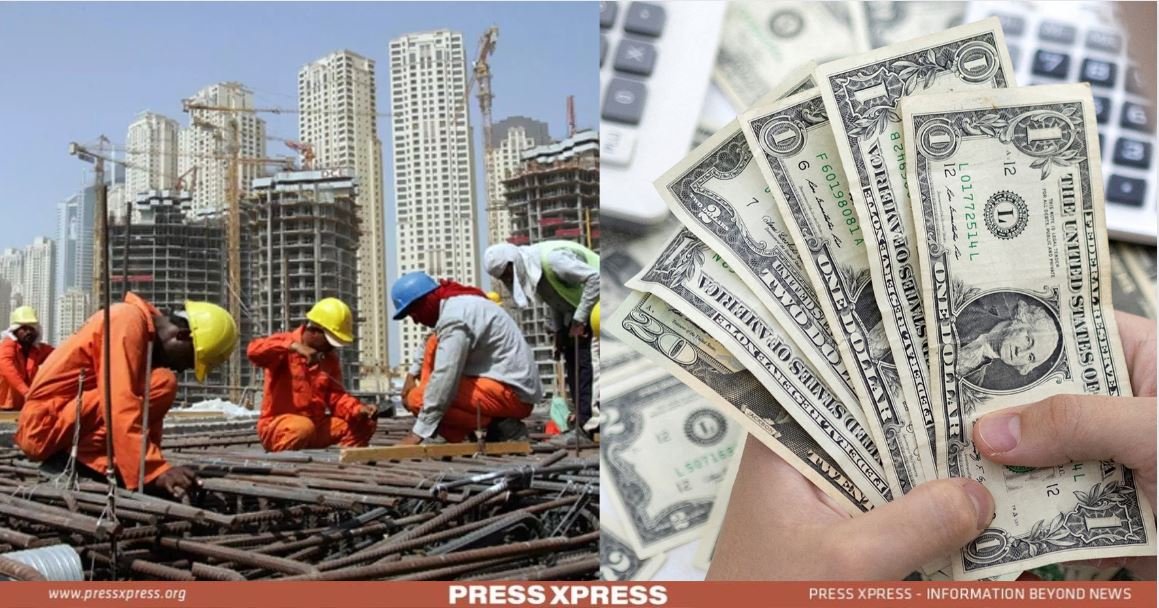Key Highlights:
- During the festive season of Eid-ul-Fitr in April, remittance inflow reached $2.04 billion, marking a marginal 2.35% rise from March 2024
- According to Bangladesh Bank’s official data, in April, $211.27 million in remittances came through state-owned banks
- In the 2022-23 period, 39.8% of migrant Bangladeshi workers migrated to Saudi Arabia, 20% to Malaysia, 15.2% to Oman, 6.9% to the United Arab Emirates, and 5.4% to Singapore
In the lead-up to Eid-ul-Fitr, remittances through banking channels in the country experienced a modest uptick in April. However, they fell short of the levels seen in the initial months of the year. During the festive season of Eid-ul-Fitr in April, remittance inflow reached $2.04 billion, marking a marginal 2.35% rise from March 2024.
Traditionally, remittance inflows surge during Eid celebrations. Yet, this April witnessed patterns akin to other months, despite expectations of increased expatriate income. An anonymous bank manager noted a lack of the usual spike in expatriate earnings compared to previous years.
Furthermore, some attribute the slight uptick in remittances to comparatively higher exchange rates offered by select banks for US dollars. April 2024’s remittance levels notably surpassed those of April 2023, showing a 21.3% increase, mirroring last year’s Eid-ul-Fitr trend.
You can also read: Why Inflation Taming Approaches Miss Bangladesh’s Market?
However, data reveals a 5.59% decrease compared to February and a 3.31% decrease compared to January 2024. Bangladesh Bank data indicates a decline in remittances sent home by expatriate Bangladeshis, with $1.99 billion in March, down from $2.16 billion in February and $2.11 billion in January.
Economists suggest that the depreciation of the dollar’s value dissuaded expatriates from utilizing banking channels to send money home. They also believe that the persistence of the hundi system poses a significant barrier to the legitimate flow of remittances, a challenge Bangladesh has yet to overcome.
According to Bangladesh Bank’s official data, in April, $211.27 million in remittances came through state-owned banks, $97.23 million through specialized banks, $1,728.08 million via private banks, and $6.48 million through foreign banks.

Remittance Slides as Hundi Bypasses Banking Channels in Bangladesh
In the fourth quarter of the 2023-24 fiscal year, inward remittance declined despite a notable rise in the number of Bangladeshi migrant workers. Bangladesh Bank data reveals that this drop is attributed to the growing utilization of informal channels such as hundi. According to the central bank’s quarterly report, remittance experienced a significant year-on-year decrease of 13.5%, reaching $4.91 billion in the July-September quarter of 2024, down from $5.67 billion in the corresponding period of the previous year.

The majority of Bangladeshi migrant workers reside in the Middle East, particularly in the Gulf Cooperation Council (GCC) countries, accounting for approximately 67.1% of the total migrant workforce, as per the banking regulator. In the 2022-23 period, 39.8% of migrant Bangladeshi workers migrated to Saudi Arabia, 20% to Malaysia, 15.2% to Oman, 6.9% to the United Arab Emirates, and 5.4% to Singapore.
A significant decrease in remittance from Bangladesh’s primary source countries, excluding the UAE, UK, and Oman, also contributed to the reduced remittance volume, according to the quarterly report. The number of registered overseas migrant workers surged to 372,100 in the three months of 2024, marking a 26.3% year-on-year increase.

Remittance Dollars Traded at Inflated Rates Amid Crunch
As per the central bank’s data, the initial cost of a dollar was Tk 104 last year, indicating a depreciation of the taka by 6 taka or 5.77%. However, in the current market scenario, dollars are not available at this rate. Presently, the purchase rate for a dollar ranges between Tk 124 to Tk 126, with some banks even offering higher rates. With an average selling rate of Tk 126 per dollar, the cost has surged by 22 Tk within a year, signifying a depreciation of around 22% in the value of the taka.
Throughout 2023, Bangladesh grappled with a severe dollar crisis in its local market, influenced by global economic downturns and domestic crises exacerbated by Russia’s invasion of Ukraine in 2022.
Currently, banks are purchasing remittances at a peak rate of Tk 109.75. Additionally, they can offer a 5% incentive, split equally between the government and the banks, totaling 2.5% each. Hence, theoretically, the dollar price should stand at Tk 119.30. However, almost all banks are acquiring remittance dollars at rates ranging from Tk 122 to Tk 126. Overseas exchange houses are not vending remittance dollars for anything less, compelling banks to procure them at these elevated costs.
Although these dollars are intended to be sold to clients at a maximum of Tk 110, commercial banks find it challenging to secure dollars at such rates from their channels, except the central bank. Consequently, in most instances, dollars for imports are being procured at rates between Tk 124 to Tk 128, with instances of even higher rates.

Liberate Exchange Rate to Unleash Economic Growth
To ensure export earnings return as anticipated and remittances flow predominantly through banking or official channels, it’s imperative to allow the market to operate freely. While there may be initial challenges, the market will eventually stabilize.
A priority for any expanding economy should be enhancing market liquidity, especially concerning foreign currency. The central bank’s role shouldn’t involve directly releasing dollars, but rather facilitating a market-driven exchange rate. Collaboration with development partners and stakeholders is crucial in achieving this goal.
In conclusion, Bangladesh’s remittance inflows witnessed a modest surge during the Eid-ul-Fitr festivities, yet fell short of expectations and prior monthly levels. This decline can be attributed to the persistent hundi system bypassing official banking channels, a depreciation of the dollar’s value deterring expatriate transfers, and a significant year-on-year drop in remittances from major source countries.
Economists advocate liberating the exchange rate to unleash economic growth, enhance market liquidity, and incentivize remittances through official channels. Ultimately, a market-driven approach in collaboration with stakeholders may be the key to revitalizing Bangladesh’s remittance lifeline and propelling its economic prospects.


